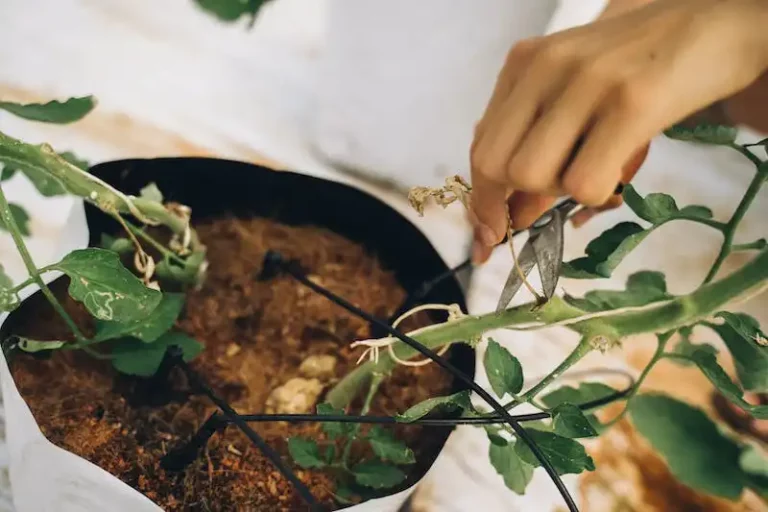The Triostar Stromanthe, also known as Stromanthe sanguinea ‘Triostar’, is a tropical plant that belongs to the Marantaceae family. It is a relative of the popular calatheas and prayer plants, known for their stunning variegation and vibrant colors. The Triostar Stromanthe is a beautiful addition to any indoor or outdoor space, with its burgundy, green, and cream-colored leaves.
When it comes to caring for the Triostar Stromanthe, it prefers to be kept in a warm and humid environment. It thrives in bright, indirect light, so it’s best to place it near a window that receives filtered sunlight. You can also grow it outdoors in a shady spot during the warmer months, but ensure that it is protected from direct sunlight.
Watering your Triostar Stromanthe is an important aspect of its care. It requires regular watering to keep the soil moist but not wet. It’s recommended to water less during the winter months when the plant is in its dormant period. To check if it needs watering, simply stick your finger about an inch into the soil. If it feels dry, then it’s time to water. Ensure that the pot has proper drainage to prevent the roots from being saturated.
Humidity is key for the Triostar Stromanthe to thrive. It prefers a humid environment, so it’s beneficial to mist its leaves regularly or place a tray of water near the plant to increase the humidity level. Another method to increase humidity is by using a humidifier. If the air in your home is dry, you may consider investing in a digital humidistat to monitor the humidity levels.
When it comes to fertilizing the Triostar Stromanthe, it’s best to use a balanced houseplant fertilizer. Feed the plant once every two weeks during the growing season, which is spring and summer. During the winter, reduce the frequency to once a month. Ensure that you dilute the fertilizer according to the instructions on the packaging to avoid overfeeding and causing damage to the plant.
Repotting the Triostar Stromanthe is necessary every two to three years, or when you notice that the plant has outgrown its current pot. Use a well-draining potting mix that contains ingredients like peat moss, perlite, and compost. When repotting, be gentle with the roots to avoid damaging them. After repotting, water the plant thoroughly to help it settle into its new pot.
The Triostar Stromanthe, like other plants, can be prone to pests and diseases. Common pests include spider mites, mealybugs, and scale insects. If you notice any of these pests, it’s important to take immediate action to prevent them from spreading to other plants. Treat the infestation using organic or chemical pest control methods, depending on your preference.
In conclusion, the Triostar Stromanthe is a stunning tropical plant that requires specific care to thrive. By providing it with the right amount of light, water, humidity, and fertilizer, you can ensure its vibrant variegation and vivid colors. Remember to regularly check for pests and diseases, and to repot it when necessary. With proper care, your Triostar Stromanthe will bring beauty and life to your indoor or outdoor space.
Stromanthe sanguinea “Tricolor”
Stromanthe sanguinea “Tricolor,” commonly known as Triostar or Tri Color Stromanthe, is a native of the tropical rainforests of Brazil. It belongs to the Marantaceae family and is a close relative of the popular prayer plant and calathea. Triostar is a stunning plant with its bold, variegated foliage that features shades of creamy white, green, and pink. The leaves have a glossy texture and an attractive pattern, making it a beautiful addition to any indoor space.
If you are thinking of growing a Triostar, here are some tips you need to know:
Light and Temperature: Triostar prefers bright, indirect light, but it can tolerate lower light conditions. Avoid exposing it to direct sunlight as it can burn the leaves. The ideal temperature range for Triostar is between 60°F (15°C) and 75°F (24°C). It doesn’t like cold drafts or sudden temperature changes, so choose a place with a nice, consistent temperature.
Watering and Humidity: Triostar requires regular watering to keep the soil evenly moist but not waterlogged. Water the plant when the top inch of soil feels dry. The humidity level should be moderate to high. You can increase humidity by placing the plant on a tray filled with water and pebbles or by using a humidifier. Brown edges on the leaves could indicate low humidity.
Soil and Repotting: Triostar prefers a well-draining soil mixture that contains ingredients such as peat moss, perlite, or vermiculite. It’s best to repot the plant every 2-3 years in the spring. When repotting, use a pot that is only slightly larger than the current one to avoid overwatering.
Fertilizing: Feed Triostar with a balanced, water-soluble fertilizer once a month during the growing season (spring and summer). Be careful not to over-fertilize as it can lead to burning of the roots.
Propagation: Triostar can be propagated through division or stem cuttings. For division, gently separate the plant into smaller clumps, ensuring each division has roots attached. With stem cuttings, take a cutting with at least two nodes and place it in a moist potting mix. Keep the soil moist and place the cutting in a warm and bright spot. Roots should develop within a few weeks.
Pest and Common Problems: Triostar is generally pest-resistant, but it can be susceptible to common houseplant pests such as spider mites and mealybugs. Keep an eye out for any signs of infestation and treat them promptly. Common problems include yellowing or browning leaves, which can indicate overwatering or underwatering. Adjust your watering routine accordingly.
Overall, Stromanthe sanguinea “Tricolor” is a stunning and relatively easy-to-grow houseplant that will thrive in a warm and humid environment. With the right care and attention, its vibrant and colorful foliage will stand out and become a true showstopper in your home.
Featured Articles by Season
Triostar Stromanthe, also known as Stromanthe sanguinea ‘Triostar’ or Stromanthe thalia ‘Triostar’, is a stunning tropical plant that is perfect for adding a pop of color to your indoor space. In this article, we will discuss how to properly care for and grow Triostar Stromanthe throughout the year.
Winter Care
During the winter months, it’s important to place your Triostar Stromanthe in a bright location with indirect sunlight. Avoid exposing it to drafts or cold temperatures, as they can cause leaf damage.
Watering should be done less frequently during winter, as the plant goes into a dormant state. Allow the top inch of soil to dry out before watering. Be mindful of overwatering, as Triostar Stromanthe is susceptible to root rot.
Spring Care
As the weather warms up in spring, you can increase the watering frequency. Keep the soil consistently moist, but not waterlogged. Mist the leaves regularly to maintain humidity, as Triostar Stromanthe prefers higher humidity levels.
This is also a good time to lightly fertilize your Triostar Stromanthe. Use a balanced, water-soluble fertilizer according to the package instructions, and apply it every month or so.
Summer Care
In summer, Triostar Stromanthe can benefit from being placed in a well-lit area with indirect sunlight. However, avoid direct sunlight, as it can scorch the leaves. If the temperature becomes too high, consider moving the plant to a slightly shadier spot.
Watering should continue to be done regularly, keeping the soil evenly moist. This is especially important in hot weather, as the plant can dry out quickly.
Fall Care
During the fall months, continue to water your Triostar Stromanthe regularly, but reduce the frequency slightly. Allow the top inch of soil to dry out before watering.
This is also a good time to check for any pests, such as spider mites or mealybugs. If you notice any signs of pest infestations, treat the plant with an appropriate pesticide or insecticidal soap.
Repotting and Propagating
Triostar Stromanthe can be repotted every 1-2 years, preferably in the spring. Use well-draining potting soil and choose a pot that is slightly larger than the current one.
To propagate Triostar Stromanthe, you can divide the plant during repotting. Separate the rhizomes with sharp, clean scissors or a knife, making sure each division has a few healthy leaves and roots. Plant each division in its own pot and provide the same care as the parent plant.
With the proper care and attention, your Triostar Stromanthe will thrive and continue to beautify your living space. If you have any further questions or need more tips, please feel free to ask within the comments!
| Season | Care Guidelines |
|---|---|
| Winter | – Place in a bright location with indirect sunlight – Avoid drafts and cold temperatures – Water less frequently and allow top inch of soil to dry out before watering |
| Spring | – Increase watering frequency – Keep soil consistently moist – Mist leaves for humidity – Lightly fertilize monthly |
| Summer | – Place in a well-lit area with indirect sunlight – Avoid direct sunlight and excessive heat – Water regularly and keep soil evenly moist |
| Fall | – Reduce watering frequency slightly – Allow top inch of soil to dry out before watering – Check for pests and treat if necessary |
| Repotting and Propagating | – Repot every 1-2 years in well-draining soil – Divide during repotting for propagation – Provide same care as parent plant |
Ask Your Gardening Question
If you have any questions about growing and caring for your Triostar Stromanthe, feel free to ask! Here are some common questions with helpful tips:
- Q: Why are the leaves on my Triostar Stromanthe turning brown?
- A: Brown spots on the leaves can be caused by either too much or too little water. Make sure you are watering your plant enough, but also allowing the soil to partially dry out between waterings. Also, be sure to use well-draining soil and a pot with drainage holes to prevent waterlogged roots.
- Q: How often should I water my Triostar Stromanthe?
- A: Triostar Stromanthe prefers to be kept consistently moist, so water whenever the top inch of soil feels dry. Be careful not to overwater, as it can lead to root rot.
- Q: Does my Triostar Stromanthe need fertilizer?
- A: Yes, your Triostar Stromanthe will benefit from regular fertilizing during the growing season. Use a balanced fertilizer diluted to half strength and apply every two weeks. Reduce the frequency to once a month in the winter months.
- Q: Where is the best place to keep my Triostar Stromanthe?
- A: Triostar Stromanthe thrives in bright, indirect light. Place it near a window where it can receive filtered sunlight. Avoid direct sunlight as it can scorch the leaves.
- Q: How do I propagate my Triostar Stromanthe?
- A: Triostar Stromanthe can be propagated through division. Carefully separate the plant into smaller sections, making sure each division has a few healthy roots. Plant the divisions in separate pots with well-draining soil and keep them warm and humid until they establish new roots.
- Q: What are some common pests that can affect Triostar Stromanthe?
- A: Triostar Stromanthe can be susceptible to pests like spider mites, aphids, and mealybugs. Regularly inspect your plant for signs of pests, including tiny webs, sticky residue, and discolored or distorted leaves. If you notice any pests, treat your plant with an appropriate insecticidal soap or pesticide.
Remember, every plant is different, so it’s important to pay attention to your individual Triostar Stromanthe’s needs. If you have any specific concerns or questions about your plant, please don’t hesitate to ask!




